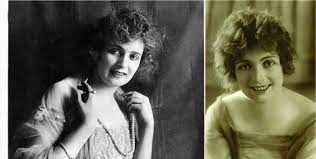Introduction to Myrtle Gonzalez
Myrtle Gonzalez, renowned as the “First Latin American Movie Star,” emerged as a trailblazing figure in the early years of Hollywood. Born on September 28, 1891, in Los Angeles, California, to Mexican immigrant parents, Myrtle’s extraordinary journey to fame began with a passion for performance that she displayed from a young age. Singing and dancing at local events, she quickly gained acclaim for her talents, eventually catching the eye of director Thomas Ince while performing in a local theater production.
Table of Contents
At a mere 19 years old, Myrtle marked her film debut in the silent western “The Invaders” (1912), setting the stage for a flourishing Hollywood career. Over the subsequent decade, she graced the screen in over 80 films, including notable works like “The Easter Lily” (1915), “The Serpent” (1916), and “One Law for Both” (1917).
Myrtle’s allure and charisma endeared her to audiences, establishing her as one of the era’s most beloved actresses. Frequently cast in roles that showcased her vivacity and comedic flair, she earned the moniker “La Única” or “the unique one.”
Beyond her acting prowess, Myrtle Gonzalez stood as a pioneer for women in the film industry. During a time when female performers were often confined to stereotypical roles as damsels in distress or femme fatales, Myrtle fearlessly embraced more dynamic characters, challenging prevailing gender norms.
Early Life and Career Beginnings
Born on September 28, 1891, in Los Angeles, California, Myrtle Gonzalez was the youngest among five siblings in the household of Mexican immigrants Francisco Gonzalez and Maria Rodriguez. Her father worked as a carpenter, while her mother dedicated her time to homemaking.
Growing up in the dynamic city of Los Angeles exposed Myrtle to a melting pot of cultures and languages. Residing in a diverse neighborhood, she acquired Spanish from her parents and English from her schoolmates.
At the age of 14, Myrtle’s life took a turn when she encountered a traveling vaudeville troupe that performed at her school. Captivated by the stage, she successfully persuaded her parents to let her join the troupe as an assistant. This pivotal experience ignited her passion for acting, laying the foundation for her aspirations to pursue it as a lifelong career.
Career Beginnings
Embarking on her artistic journey, Myrtle commenced her performances in local theaters across Los Angeles, diligently refining her craft as an actress. Concurrently, she immersed herself in dancing, undertaking lessons that culminated in proficiency across diverse styles, including ballet and flamenco.
A pivotal moment unfolded in 1911 when, at the age of 20, Myrtle secured her inaugural film role in “The Immigrant,” directed by D.W. Griffith. While her part was modest in scale, this cinematic opportunity served as the auspicious inception of her triumphant career in Hollywood.
Rise to Fame in Silent Films
Myrtle Gonzalez, renowned as “The Virgin of the Silver Screen,” achieved stardom as a Mexican-American actress during the early 1900s, captivating audiences with her performances in silent films. Overcoming the challenges posed by limited opportunities for Hispanic actors at the outset of her career, Myrtle’s talent and unwavering determination propelled her to become one of the most sought-after actresses of her era.
Born on September 28, 1891, in Los Angeles, California, Myrtle, raised by her Spanish mother and American father, cultivated a passion for acting in her diverse community. Participating in local theater productions showcased her natural grace and poise, catching the attention of film producer Mack Sennett, who extended a contract offer with his company, Keystone Studios.
Myrtle’s cinematic debut in 1913 with the short film “Giving Them Fits” marked the inception of a remarkable career spanning over two decades. Recognized for her expressive eyes and the ability to convey emotions sans words, she progressed to prominent roles in feature films like “Love’s Forgiveness” (1915) and “The Silent Witness” (1917).
However, it was her collaboration with renowned comedian Roscoe ‘Fatty’ Arbuckle in “Fatty’s Plucky Pup” (1915) that catapulted Myrtle to widespread recognition.
Personal Life and Relationships
Myrtle Gonzalez’s personal life and relationships played a pivotal role in shaping both her identity as an actress and as an individual. Born on September 28, 1891, in Los Angeles, California, to Mexican parents—her father a stage actor and her mother a singer—Myrtle’s early exposure to the world of performance laid the foundation for her lifelong passion.
Growing up surrounded by a close-knit family, Myrtle frequently accompanied her parents to their performances, forging a deep connection to the world of entertainment. At the age of 16, she made her stage debut, earning acclaim for her acting skills. However, it was her foray into the film industry that propelled her to widespread recognition.
In matters of the heart, Myrtle experienced two marriages. Her first union was with silent film director George Marshall in 1913, lasting six years before concluding in divorce due to personal differences. In 1929, Myrtle entered matrimony again, this time with cinematographer Allen McNeil. Their union endured until his passing in 1950.
Despite the challenges in her romantic life, Myrtle maintained a positive outlook and unwavering dedication to her career. She fostered strong friendships within the film industry, cultivating lasting bonds with fellow actresses Dolores Del Rio and Ramona Novarro.
Legacy of Myrtle Gonzalez
The enduring legacy of Myrtle Gonzalez continues to serve as a wellspring of inspiration for generations of actors and actresses within the film industry. As one of the earliest Mexican-American talents to achieve success in Hollywood, Myrtle blazed a trail for future Latinx performers and played a pivotal role in dismantling barriers to representation in the entertainment realm.
Born on September 28, 1891, in Los Angeles, California, Myrtle Gonzalez’s trajectory towards stardom seemed predestined from an early age. With a mother immersed in theater acting and a father esteemed as a theater manager, Myrtle’s inherent love for performance blossomed. Her stage debut at the tender age of three marked the inception of a lifelong journey in acting.
Following her high school graduation, Myrtle dedicated herself to a full-time acting career, securing minor roles in silent films before catching the discerning eye of movie producer Thomas Ince. Recognizing her potential, Ince entrusted Myrtle with the lead role in “A War-Time Widow” (1915), catapulting her into stardom and establishing her as one of Hollywood’s leading ladies.
Myrtle’s magnetic beauty, charisma, and innate acting prowess swiftly endeared her to audiences, earning her the moniker “The Virginian Beauty” for her role as Milly Erne in “The Virginian” (1914).
Controversies and Scandals
Like many celebrities, controversies and scandals became integral aspects of Myrtle Gonzalez’s life, despite her flourishing career in Hollywood. Her personal life was not shielded from the scrutiny that often accompanies fame.
One particularly notorious controversy involving Myrtle was her entanglement with director Herbert Blaché. At the time, Blaché was married to Alice Guy-Blaché, a luminary in the early cinema scene. However, an affair with Myrtle led to Blaché’s divorce from Alice in 1922. This scandal reverberated through Hollywood, casting a shadow over both Blaché’s and Myrtle’s reputations.
Another persistent source of controversy throughout Myrtle Gonzalez’s career was her Mexican heritage. Despite her birth in Los Angeles and Spanish ancestry, she faced discrimination based on her appearance and surname. In an era when acceptance of Mexican Americans in Hollywood was limited, Myrtle grappled with the challenge of breaking free from stereotypical roles, contending with labels like “the exotic temptress” or “the fiery Latina.”
Additionally, rumors circulated regarding Myrtle’s romantic life. Known for her flirtatious demeanor on set, she was romantically linked with several co-stars. One of the most talked-about relationships was allegedly with actor Francis X. Bushman, a major Hollywood star at the time. Though never officially confirmed, their rumored romance stirred scandal, particularly as Bushman was married during that period.
Influence on Hollywood and Pop Culture
Myrtle Gonzalez, renowned as “the American Beauty,” made a significant mark as a silent film actress in the early 20th century, leaving an enduring legacy that resonates in Hollywood and pop culture to this day.
Her ascent to stardom commenced with a standout performance in the 1914 film “The Count of Monte Cristo.” Possessing a natural beauty and an enthralling on-screen presence, Gonzalez swiftly captured the attention of both audiences and critics. With each subsequent role, her popularity soared, firmly establishing her as one of the era’s most coveted actresses.
Gonzalez’s impact on Hollywood transcends her cinematic contributions, notably in her pioneering efforts to redefine the portrayal of female characters in films. In an era where women were often confined to roles as damsels in distress or femme fatales, Gonzalez introduced depth and complexity, challenging societal norms and paving the way for future female leads.
Beyond her groundbreaking influence on gender representation, Gonzalez emerged as a trailblazer for Latinx actors in Hollywood. As one of the earliest and most successful Mexican-American actresses, she shattered barriers and created opportunities for minority performers. Her roles defied stereotypes, proving that individuals from diverse backgrounds could thrive in an industry predominantly dominated by white actors.
Gonzalez’s impact extended well beyond the confines of Hollywood, permeating pop culture of her time. Admired for her beauty, she became an idol for fans across America, inspiring fashion trends that mirrored her distinctive style.
Remembering Myrtle Gonzalez: Honors and Tributes
Myrtle Gonzalez, recognized as the inaugural Latin American movie star, remains a celebrated and revered figure, with her remarkable contributions to the film industry enduring in various honors and tributes.
Despite the brevity of her Hollywood career, the legacy she forged has paved the way for subsequent generations of Latino actors. This section will delve into the array of accolades and commemorative events dedicated to Myrtle Gonzalez, illustrating how her impact on cinema continues to be acknowledged and cherished.
- Posthumous Awards
Despite departing at the young age of 27, Myrtle Gonzalez’s talent endured and garnered posthumous acclaim. Notably, in 1919, Photoplay Magazine honored her with a Bronze Plaque for her outstanding performance in “The Mexican,” recognized as one of her exemplary roles.
Furthermore, in 1920, Alma de Mexico magazine bestowed upon her an honorary award, acknowledging Myrtle as “the most beautiful woman in Mexico.” These posthumous accolades stand as enduring testaments to Myrtle’s profound impact on audiences, both in America and Latin America.
- Star on the Hollywood Walk of Fame
The Hollywood Walk of Fame bestowed a distinguished honor upon Myrtle Gonzalez in 1960 when she was commemorated with a star. This accolade, recognized as one of the highest in the entertainment industry, is reserved for individuals who have made substantial contributions to the field.
Conclusion
In summary, Myrtle Gonzalez stands as a trailblazing actress from the formative years of Hollywood, contributing significantly to the shaping of the film industry. Despite confronting numerous challenges and obstacles, her unwavering dedication to her craft resulted in a lasting legacy that serves as an enduring source of inspiration for generations of actors and actresses.
Myrtle Gonzalez’s indelible impact on the history of cinema is undeniable, cementing her as a pivotal figure in the realm of entertainment. Through her exceptional talent, steadfast determination, and profound love for acting, she remains a revered figure, forever remembered as one of the pioneering Mexican-American stars in Hollywood.










